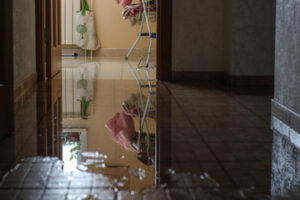Water damage restoration is vital because if left untreated, it can lead to mold growth, structural weakening of the building structure, and electrical hazards. Addressing water damage promptly also prevents health problems like respiratory issues and allergies.

The water restoration process begins with a thorough inspection of the affected area. This helps determine the source of the water and document the damage for insurance claims. Visit https://www.allproutah.com/ to learn more.
Water damage can be caused by many different things, including heavy rainstorms, floods, bursting pipes, and even faulty appliances. It can happen to homes and businesses alike, and it is something that should be addressed as soon as possible. Not only does it damage personal belongings, but it can also lead to costly structural damage and bacterial growth. It is important to note that the longer water sits, the more damage it causes. That is why it is crucial to act fast and hire professional water restoration services as soon as you notice any signs of water damage in your home or business.
One of the first things you will want to do is make sure that you turn off your main water supply to prevent more water from entering the space. You will also want to turn off any electricity to the affected area to avoid potential electrical hazards. Once you have done this, you should begin examining the area for any visible signs of water damage. This may include stains or discoloration on the ceilings, walls, or floors. You may also find that wood is sagging or that metal items are rusting.
Often, you can easily find the source of the water damage by looking for a leaky faucet or fixture. However, sometimes it can be more difficult to locate the source. This is when you will want to consult a professional. They can use special tools and equipment to identify the location of a leaky pipe or appliance.
They can also help you to decide how severe the damage is and provide you with an estimate. They can also determine the type of water damage, which is important because it dictates how safe it is to enter the space and what types of repairs will need to be made.
If the water damage is classified as category 3 or above, it will require immediate action to minimize health risks and damage to the building materials. It is essential that you contact a professional water restoration service who has received HAZWOPER training. This is required by OSHA to ensure that technicians have the necessary skills and knowledge to handle dangerous materials safely.
Identifying the Type of Water
If your home or business has experienced water damage, the first step to a full restoration is identifying the type of water that caused the problem. This is crucial, as different types of water require different repair methods. If you’re not familiar with the different kinds of water, contacting a professional for immediate assistance is critical to preserving your belongings and property.
The first step of the water damage restoration process involves a thorough inspection and assessment. This helps the professionals determine the extent of the damage and what is needed to restore the affected area to its original state. It also helps them identify potential safety issues, such as electrical hazards or sewage contamination.
Once the inspection and assessment are complete, the next step is to remove any standing water. This is done by pumping or vacuuming the water away from the damaged area. It is important to remove as much water as possible, as it can increase the likelihood of successful restoration and reduce overall costs.
After the removal of standing water, the drying and cleaning process begins. This is a vital step in the water damage restoration process, as it can minimize or even prevent permanent damage to your property and belongings. It is essential to dry all materials as quickly as possible, as it only takes 24 hours for mold and mildew to begin growing. This is achieved by removing affected items, opening windows, and using fans to promote airflow and assist in the drying process.
Depending on the severity of the damage, drywall may need to be replaced. However, if only a small amount of water has soaked into the drywall, it can usually be restored with minimal cost. On the other hand, if the drywall is heavily saturated or contaminated with grey or black water, it will most likely need to be replaced.
Water damage can have a serious impact on property value. It can cause discoloration, odors, and structural damage that may deter buyers or renters from relocating to your property. By hiring professional water damage restoration services, you can protect your property’s value and ensure a smooth transition for potential tenants or buyers.
Getting Rid of Standing Water
Standing water in your yard may seem like a minor nuisance at first. After all, it will eventually evaporate or soak into the soil. However, puddles can actually pose significant problems for your lawn and property if left unattended. These pools of stagnant water can suffocate plants, hinder grass growth, and create an environment for mosquitoes to thrive in. They can also damage your home’s foundation, basement, or outdoor structures. They can even cause mud to track inside, creating additional water damage and a messy clean up.
Water restoration companies start with a thorough inspection of the affected area to identify the extent of the problem. This process includes a visual inspection as well as testing the moisture levels in the affected areas. This is a crucial step because it allows professionals to get a better idea of the extent of the damage and make informed decisions about how to repair the issue.
Once the inspection is complete, the next step in the water damage restoration process is to remove any excess moisture from the affected areas. This can be done by using various equipment and drying methods. This is a critical part of the water damage restoration process because it prevents secondary damage from occurring, such as mold growth.
In addition to causing structural damage, standing water can pose health risks for people living in the affected buildings or homes. This is because the contaminated water can harbor harmful bacteria and other microorganisms that can cause infections in open wounds or cuts. This is especially dangerous for individuals with weak immune systems or chronic health conditions.
Stagnant water can also be a safety hazard for people walking on it. The slick surface of the water makes it easy to lose your footing, which can lead to serious injuries, especially for children and older adults. This can have lasting effects on a person’s physical and mental health.
Standing water is a major headache for many homeowners and businesses. In addition to being unsightly, it can create health and safety hazards and lead to costly repairs and lost revenue. Fortunately, there are steps that can be taken to prevent standing water in the future, such as improving drainage or adding mulch. By taking proactive measures, you can minimize the amount of time and money spent on water damage restoration in the future.
Getting Help
As soon as possible, it is important to get professional help for water damage restoration. This is because the longer that water sits on a property, the more damage it causes. For example, moisture can cause drywall and wood to warp and crack, which leads to costly repairs down the line. Additionally, moisture can promote the growth of mold and mildew, which can pose serious health risks for people and pets.
Getting professional assistance also helps to ensure that the restoration process is carried out efficiently and thoroughly. This is because a professional can assess the damage and develop a disaster recovery plan. Additionally, they can address complications that may not be immediately apparent.
Water damage can be caused by many different factors, including natural floods, burst pipes, sewage backups, and more. In addition, it can be hard to tell the extent of the damage because moisture and debris hides behind walls, under flooring, and in other areas. As such, it is important to understand what to look for in order to address the problem as quickly as possible.
For example, one way to protect a home from future damage is to insulate its pipes. This can be done professionally or at a DIY level. In addition, it is important to keep up with regular maintenance and inspections of plumbing systems. This will help to prevent small problems from becoming major disasters down the line.
Lastly, it is important to document the damage as much as possible. This will come in handy when filing a claim with an insurance company. This step will help to determine the full extent of the damage and provide a detailed timeline of what happened.
While it is possible to mitigate the effects of water damage by taking several steps on your own, professional help is often necessary. Water damage restoration experts can ensure that the damage is contained as quickly as possible, and can minimize the cost of repairs by acting fast. They can also help to prevent the growth of mold and mildew, and address any other problems that might not be immediately evident.
